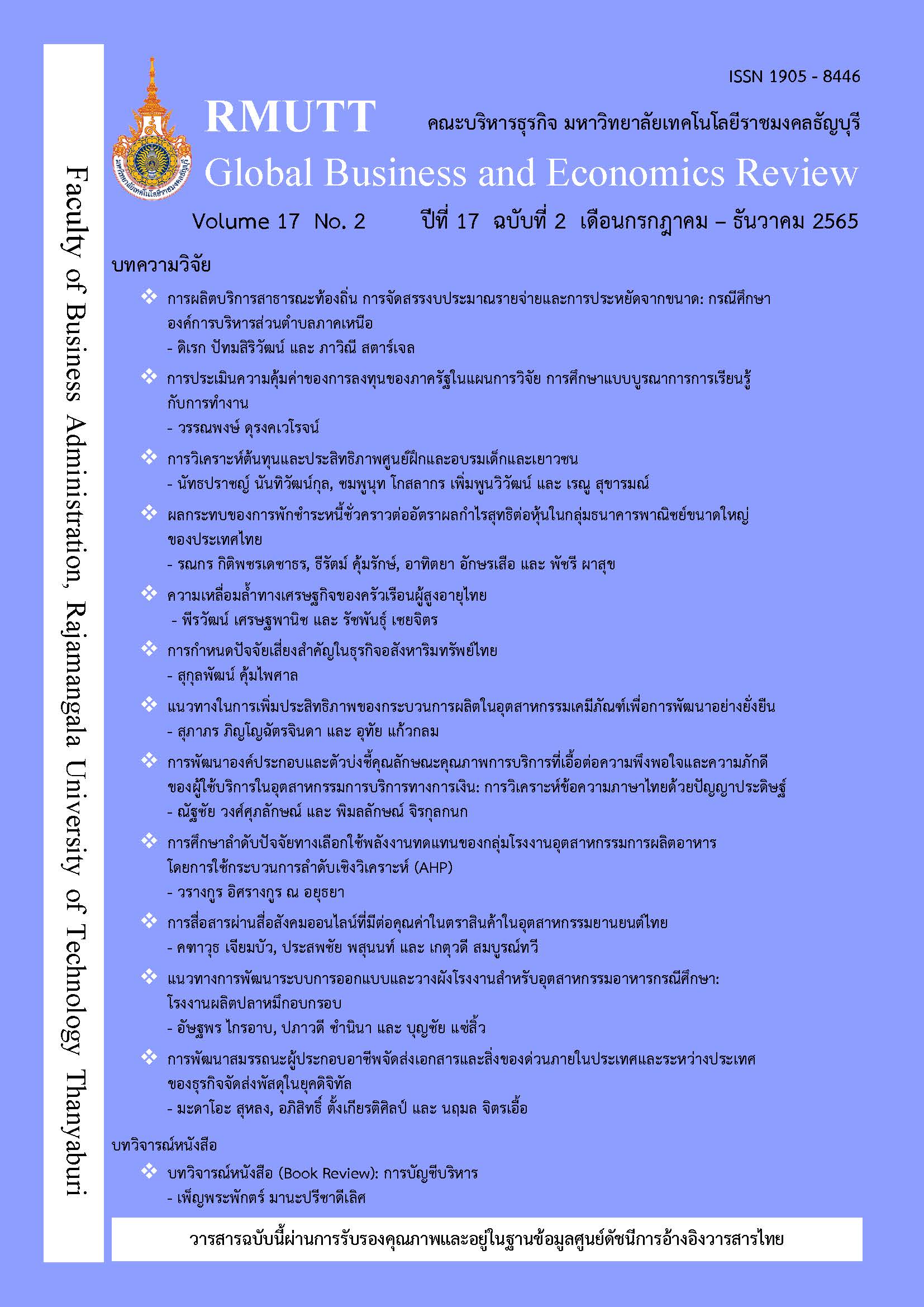A STUDY RANKING OF ALTERNATIVE ENERGY FACTORS FOR THE FOOD PRODUCTION INDUSTRY GROUP VIA USING ANALYTICAL HIERARCHY PROCESS (AHP)
Keywords:
Analytic Hierarchy Process, Biomass, Renewable Energy, Food IndustryAbstract
At present, the world has faced the problem of global warming. And the heat is increasing every year as a result of the flue gas pollution. Caused by being released from the activities of human beings, especially in the activities in the food manufacturing industry that uses fuel energy including various processes within the food manufacturing industry that causes pollution as mentioned above is very much. Therefore, it is increasingly important to bring clean energy into industrial processes. From the study in this research, the focus is to study the alternatives of biomass energy with quality and potential. By choosing to use renewable energy from palm bunches to be used as a substitute for fuel oil use. and study the overview of palm oil and palm oil industry Cultivated area The area with the production and quantity of oil palm of the country renewable power generation instead of using fuel oil Including the development and improvement of the energy potential database to be up-to-date. Convenient to use, etc. From this research, the results of the research were analyzed using the Expert Choice program. The calculations were made using the analytical hierarchical process technique to determine the alternative energy weight. Importance under the power factor price factor quality factor service factor and maintenance factors the mean weights of the factors could be summed up as 0.42, 0.21, 0.27, 0.17 and 0.15, respectively, and the weights of the factors in alternative energy from palm shells, wood chips, sawdust, shavings, biomass briquettes, and others. The weight of alternatives can be summed up as 2.81, 1.94, 1.88, 1.73 and 1.64, respectively. The results obtained from using the AHP hierarchy are applied to the choice of alternative energy in the food manufacturing industry.
References
นฤมล แสวงผล. (2554). ปัจจัยที่มีผลต่อความสุขในการทำงานของบุคลากร คณะบริหารธุรกิจ มหาวิทยาลัยเทคโนโลยีราชมงคลธัญบุรี. (การค้นคว้าอิสระปริญญามหาบัณฑิต, มหาวิทยาลัยเทคโนโลยีราชมงคลธัญบุรี).
บุญธรรม กิจปรีดาบริสุทธิ์. (2549). ระเบียบวิธีการวิจัยทางสังคมศาสตร์ (พิมพ์ครั้งที่ 10). กรุงเทพฯ: จามจุรีโปรดักท์.
วิมลรัตน์ หมั่นเพียร. (2559). การประยุกต์ใช้เทคนิคกระบวนการวิเคราะห์แบบลำดับชั้นเพื่อคัดเลือกผู้บริการรับเหมาแรงงาน. (สารนิพนธ์ปริญญามหาบณฑิต, มหาวิทยาลัยบูรพา).
ศิริชัย กาญจนวาสี และคนอื่น ๆ. (2535). การเลือกใช้สถิติที่เหมาะสม สำหรับการวิจัยทางสังคมศาสตร์. กรุงเทพฯ: จุฬาลงกรณ์มหาวิทยาลัย.
สิรินทร แซ่ฉั่ว. (2553). ความสุขในการทำงานของบุคลากรเชิงสร้างสรรค์: กรณีศึกษาอุตสาหกรรมเชิงสร้างสรรค์กลุ่มสื่อและกลุ่มงานสร้างสรรค์เพื่อการใช้งาน. (วิทยานิพนธ์ปริญญามหาบัณฑิต, สถาบันบัณฑิตพัฒนาบริหารศาสตร์).
Birol. (2015). The international energy ministers from IEA recommends to reduce GHC. https://www.iea.org/media/presentations/Energy_Matters_brochure.PDF
Diener, E. (2009). Culture and well-being. London: Springer Dordrecht Heidlberg.
Kim, J. O., & Mueller, C. W. (1978). Factor analysis: statistical methods and practical issues. Beverly Hills, CA: Sage.
Krejcie, R. V., & Morgan, D. W. (1970). Determining sample size for research activities. Educational and psychological measurement, 30(3), 607-610.
Saaty, T. L. (1980). The Analytic hierarchy. New York: McGrow-Hill.
U.S. Energy Information Administration. (2016). Retrieved from https://www.connaissancedesenergies.org
Warr, P. (1990). The Measurement of Well-Being and Other Aspects of Mental Health. Journal of Occupational Psychology, 63, 193-210.
Downloads
Published
How to Cite
Issue
Section
License
Copyright (c) 2022 Varangkoon Issaragura Na Ayuthaya

This work is licensed under a Creative Commons Attribution-NonCommercial-NoDerivatives 4.0 International License.
The articles published in this journal are the intellectual property of their respective authors.
The views and opinions expressed in each article are solely those of the individual authors and do not reflect the positions of Rajamangala University of Technology Thanyaburi or any of its faculty members. All components and content of each article are the sole responsibility of the respective authors. In the event of any errors, the authors shall bear full responsibility for their own work.








